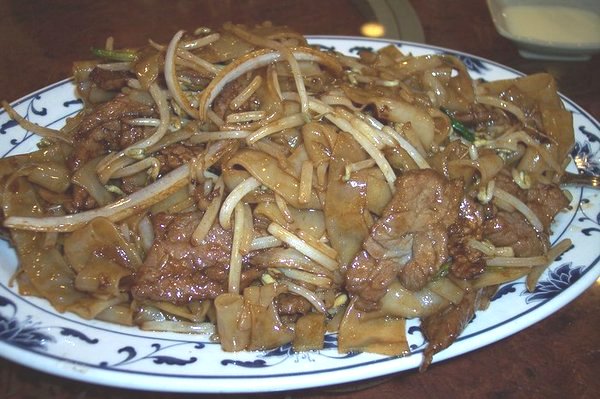Year of the Noodle - by MojoRider
If I eat too much American cuisine for a long time, I get a huge hankering for Asian cuisine. I gotta have some rice and get away from potatoes. I don't care what it is: Japanese, Thai, Vietnamese, or Chinese, Korean. I am partial to Chinese cuisine and I am always amazed at the culinary variety of things that can come from a Chinese chef. I can be a little bit of a noodle freak, though---seriously, who doesn't like noodles? Be it won ton noodle soup, or a chow foon, a pad thai, key mow, or udon. It's all good stuff.

The other month, the Washington Post's food section did a story on Asian noodles:
Whether they're buckwheat-based soba, wheat-based udon, cellophane, rice or egg, Asian noodles are hitting their stride as one of the city's most versatile, inexpensive comfort foods. And while a bowl of noodles is gaining cachet -- just ask foodies waiting to see whether the London-based Wagamama really opens in Penn Quarter this May -- noodle houses have flourished in Washington for as long as the area has been home to Chinese, Vietnamese, Korean and Thai immigrants. When the Lunar New Year begins Sunday (coincidentally, Valentine's Day), the two-week celebration will see many Asian families feasting on long, uncut noodles, which symbolize longevity, as well as fish, various meats, mandarin oranges and dumplings, the latter two a nod to good fortune.
Which cultures use what noodles? Author Corinne Trang says, "Noodles are actually simpler than they seem," but for the noodle illiterate, the vast array is dizzying. How do you know what to order where, or what to buy if cooking them at home? Ingredients aside, noodles can be long or short, thick or thin, curly or flat or round, fresh or dried, any of which might be better suited for boiling, steaming, stir-frying or braising....
One of the darlings of the noodle world, New York chef David Chang, likens Americans' lack of familiarity with Asian noodles to the situation with Italian noodles 20 or more years ago. "Today, people know tagliatelle, pappardelle, bucatini, linguini, fettuccini," says Chang, who owns such restaurants as Momofuku and Noodle Bar. "Hopefully, the next decade will be the same for Asian noodles, and people will come to know Asian noodle flavors, shapes and sizes...."Who doesn't like noodles?" says DC Noodles' manager, Tom Farobon, who is originally from Thailand. "In my culture, we eat them for breakfast, lunch and dinner." Farobon says the shop is doing well in a down economy because it's the right price point.
You can't read an article like that and not get the craving for noodles. Oh, and I had a big plate of Singapore rice noodles for lunch yesterday in Chinatown!

The other month, the Washington Post's food section did a story on Asian noodles:
Whether they're buckwheat-based soba, wheat-based udon, cellophane, rice or egg, Asian noodles are hitting their stride as one of the city's most versatile, inexpensive comfort foods. And while a bowl of noodles is gaining cachet -- just ask foodies waiting to see whether the London-based Wagamama really opens in Penn Quarter this May -- noodle houses have flourished in Washington for as long as the area has been home to Chinese, Vietnamese, Korean and Thai immigrants. When the Lunar New Year begins Sunday (coincidentally, Valentine's Day), the two-week celebration will see many Asian families feasting on long, uncut noodles, which symbolize longevity, as well as fish, various meats, mandarin oranges and dumplings, the latter two a nod to good fortune.
Which cultures use what noodles? Author Corinne Trang says, "Noodles are actually simpler than they seem," but for the noodle illiterate, the vast array is dizzying. How do you know what to order where, or what to buy if cooking them at home? Ingredients aside, noodles can be long or short, thick or thin, curly or flat or round, fresh or dried, any of which might be better suited for boiling, steaming, stir-frying or braising....
One of the darlings of the noodle world, New York chef David Chang, likens Americans' lack of familiarity with Asian noodles to the situation with Italian noodles 20 or more years ago. "Today, people know tagliatelle, pappardelle, bucatini, linguini, fettuccini," says Chang, who owns such restaurants as Momofuku and Noodle Bar. "Hopefully, the next decade will be the same for Asian noodles, and people will come to know Asian noodle flavors, shapes and sizes...."Who doesn't like noodles?" says DC Noodles' manager, Tom Farobon, who is originally from Thailand. "In my culture, we eat them for breakfast, lunch and dinner." Farobon says the shop is doing well in a down economy because it's the right price point.
You can't read an article like that and not get the craving for noodles. Oh, and I had a big plate of Singapore rice noodles for lunch yesterday in Chinatown!



Comments
Ramen, ha ha! yeah, the stuff that kept us going thru college. I no longer buy the Americanized version, the Maruchan ramen. Although, I did find a very healthy ramen noodle once in an Asian market, I think it's a Tawainese noodle company?. They did not deep fry their instant noodles, so you had to boil the noodles for at least 5 minutes.
The only ramen instant noodles I use now are the Kung Fu Mien brand. I occasionally pick up a case of 30 packages at the Asian food market. My cousin likes Tung I instant noodles but I found it to be really high in fat content.